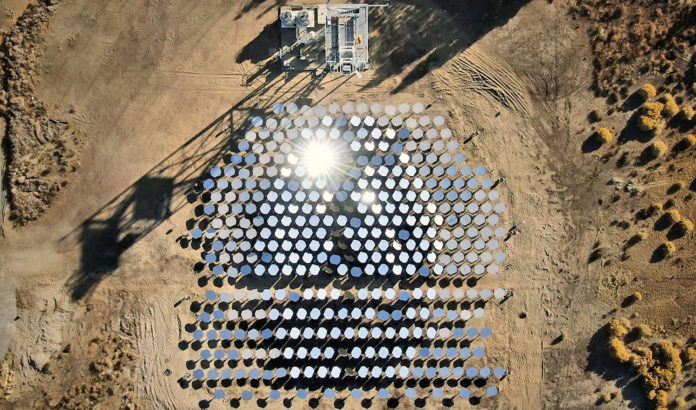In an attempt to bring carbon-free energy to the heavy industry, the renewable energy technology company Heliogen announced that international mining and metals company Rio Tinto plans to deploy Heliogen’s breakthrough solar technology at Rio Tinto’s borates mine in Boron, California. The world’s second-biggest miner has committed to reducing its emissions by 15% by 2030.
Heliogen says this will be the first concentrated solar technology used to power a mine in the United States and perhaps in the world. The company will deploy its proprietary, artificial intelligence (AI)-powered technology and a set of computer-controlled mirrors at the Boron operation.
The huge arrays of mirrors surround a tall tower, each of which tracks the Sun’s position in the sky and tilts itself to perfectly reflect the sunlight onto a collector in the top of the tower. It will use heat from the Sun to generate carbon-free energy used to make steam. The system will also store the captured energy in the form of heat, allowing it to power nighttime operations. This provides the same uninterrupted energy stream offered by legacy fuels.
The startup says its demo plant in Lancaster, California, recorded temperatures exceeding 1,000 °C, using a relatively small field of AI-guided mirrors. The company is now talking about temperatures over 1,800 °C. This carbon-free, ultra-high temperature heat can be used to power heavy industrial processes, including the making of cement, steel, and petrochemicals, and mining, which normally depends on fossil fuels to power their operations.
Rio Tinto’s boron operation, rather fittingly located in Boron, California, currently generates steam using a natural gas cogeneration plant and natural gas-fired boilers. Heliogen’s installation will supplement these energy sources by generating up to 35,000 pounds per hour of steam to power operations.
Rio Tinto says this has the potential to reduce carbon emissions at the Boron site by around 7% – equivalent to taking more than 5,000 cars off the road. Rio Tinto will also be assessing the potential for larger-scale use of the Heliogen technology at Boron to reduce the site’s carbon footprint by up to 24%.
The two companies will begin detailed planning and securing government permits for the project, with the aim of starting operations from 2022. The companies will also use the Boron installation to explore the potential for deployments of Heliogen’s technology to really replace the fossil fuels used to power large-scale industrial operations. And that can help a lot in combating the climate crisis.
